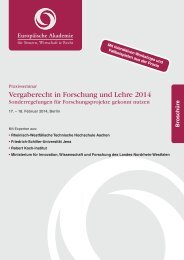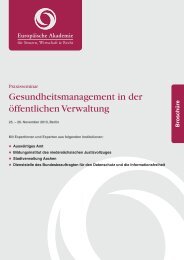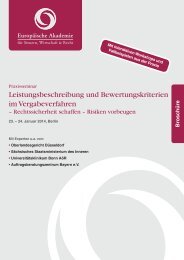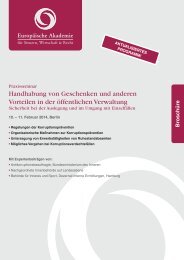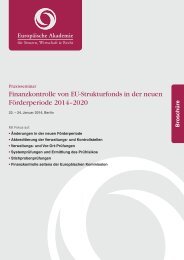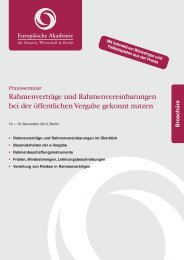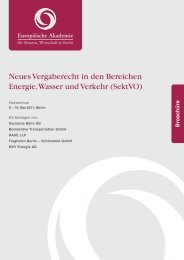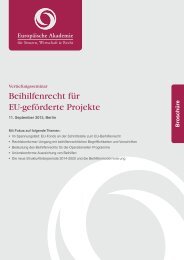Disaster ManageMent - - Europäische Akademie für Steuern ...
Disaster ManageMent - - Europäische Akademie für Steuern ...
Disaster ManageMent - - Europäische Akademie für Steuern ...
You also want an ePaper? Increase the reach of your titles
YUMPU automatically turns print PDFs into web optimized ePapers that Google loves.
09 / 2010<br />
Floods in poland 2010: tHw high-capacity-pumps lower<br />
water levels<br />
Essay by Christian Goihl, Project Manager ETS, Unit E 2, Federal Agency for Technical Relief (THW), Germany<br />
In May and June, large areas of Poland<br />
were flooded for weeks on end and the<br />
floodwaters threatened to cross the border<br />
into Germany. During the first and the<br />
second wave of the floods the German<br />
areas were not strongly affected, but the<br />
Polish villages were heavily hit. So, the<br />
EU, Germany and also then the THW were<br />
asked twice to support the Polish rescue<br />
units in its struggle to contain the floods<br />
with its High Capacity Pumping Modules<br />
(HCP). In both operations over 1.5 billion<br />
litres of water were pumped away with<br />
a total of 300 THW volunteers in action<br />
during the whole mission period in Poland.<br />
Sandbags enforce the banks to stop the<br />
water<br />
Heavy rain in May led to many rivers<br />
bursting their banks in Poland, the Czech<br />
Republic, Hungary, Slovakia and Serbia.<br />
The situation in the other countries quickly<br />
returned to normal, but in Poland it took on<br />
disastrous proportions. Southern regions<br />
of the country disappeared under water<br />
and thousands of people had to leave their<br />
homes. In the middle of May a dam burst in<br />
Kraków as the River Vistula swelled to its<br />
highest level since 40 years. In response,<br />
on May 19 the Polish government requested<br />
assistance via the EU’s Monitoring and<br />
Information Centre (MIC) in Brussels.<br />
In accordance with the EU Community<br />
Mechanism, assistance for the Polish fire<br />
department in its struggle against the floods<br />
was provided by deploying HCP modules<br />
to the crisis area from France (four), the<br />
Baltic states (one) and Germany (five).<br />
The five HCP modules use an extra-highcapacity<br />
channel impeller pump known to its<br />
users as the “calamity pump” because of its<br />
high flow rate of 15,000 litres per minute, as<br />
well as two other high-capacity pumps with<br />
flow rates of 5,000 l/min. These heavy-duty<br />
pumps allowed 200 THW volunteers (incl.<br />
replacement teams), present in the first<br />
mission phase, to drain streets, industrial<br />
plant, pumping stations and entire housing<br />
estates. After days of pumping, the water<br />
levels finally began to recede and the<br />
situation eased off somewhat. One after<br />
the other, the German HCP modules were<br />
able to end their intervention in the flooded<br />
areas during the first week of June.<br />
The water returns<br />
However, the returning units had only just<br />
begun to hang up their boots to dry when<br />
the call came to deploy further units for<br />
another mission to Poland. Fresh rainfall<br />
in mid-June once again led to river levels<br />
rising and, particularly in the southeastern<br />
parts of Poland, the dykes could<br />
no longer hold back the water. Within a few<br />
days, recently drained areas were flooded<br />
anew. Sandomierz and Tarnobrzeg were<br />
particularly badly affected so the Polish<br />
government again requested assistance.<br />
They were already back in action on June<br />
14th, operating around the clock. At peak<br />
capacity they were pumping a total of<br />
110.000 litres of water per minute back<br />
over the dykes.<br />
700 million litres in nine days<br />
The town of Tarnobrzeg was one of the<br />
areas that suffered the most. Eight weeks<br />
after the first dams burst, the floodwater<br />
in the Wielowies district was still several<br />
metres deep, covering an area of five square<br />
kilometres. This part of the town lies in a<br />
depression. The water could not flow back<br />
into the Vistula river, transforming the area<br />
into an artificial lake. THW volunteers from<br />
the regional offices Hamburg / Mecklenburg<br />
- Western Pomerania /Schleswig-Holstein/<br />
Bremen and Lower Saxony were here in<br />
action for nine days, pumping more than<br />
700 million litres of water out of this one<br />
housing estate alone. In Sandomierz, THW<br />
volunteers from North Rhine-Westphalia<br />
pumped water from a housing estate into a<br />
harbour basin more than 300 metres away.<br />
Before they could start, however, to lay their<br />
hoses under the surface, they had to open<br />
the surface of a heavily used road with the<br />
support of a local building company.<br />
Meanwhile, in Janowiec, a HCP module<br />
was draining water away from the local<br />
pumping station. Because of the floods,<br />
an ordinarily small stream was unable to<br />
flow into the Vistula river, flooding a large<br />
part of the 1,000-inhabitant town, including<br />
its local pumping station. One extra-highcapacity<br />
pump and two high-capacity<br />
pumps were in action, with a combined<br />
flow rate of some 20,000 litres per minute<br />
helping to lower the water level for more<br />
than one metre. Afterwards submersible<br />
pumps were used to remove the remaining<br />
water from the pumping station. Water<br />
was also pumped back over the dykes in<br />
Las Debowy, near Opole Lubowski. The<br />
THW-experts, who operated in this area,<br />
came from Hesse/Rhineland-Palatinate/<br />
Saarland.<br />
Water levels finally dropped<br />
After two weeks the flood waters were<br />
retreating at last in the affected areas<br />
of Poland. Isolated ‘lakes’ remained but<br />
the water no longer covered large areas.<br />
5<br />
THW volunteers were able to finish their<br />
missions as the local authorities took over<br />
the remaining “pumping and clearing up” -<br />
tasks.<br />
In total, this THW mission in Poland<br />
amounted to several thousand working<br />
hours and pumped more than 1.5 billion<br />
litres of water. It ended on June 30th, 2010.<br />
In June 2010 the THW pumped down more<br />
than one billion litre of water<br />
Christian goihl<br />
is speaker at the<br />
short notice tHw<br />
european Conference:<br />
<strong>Disaster</strong> Management<br />
22 nd to 24 th November 2010,<br />
Berlin<br />
Christian Goihl is Project Manager of the<br />
“Emergency Temporary Shelter-Modules”project<br />
at in the headquarters of the German<br />
Federal Agency for Technical Relief (THW)<br />
in Bonn, Germany. Additionally, he has been<br />
working as volunteer with THW and Malteser<br />
Emergency Service in Cologne in the area of<br />
Civil Protection and Rescue Services. Due to<br />
his work at Siemens IT Solutions and Services<br />
in Paderborn and Munich he gained experiences<br />
in Business Continuity Management as<br />
well as in <strong>Disaster</strong> & Risk Prevention. He studied<br />
Rescue Engineering at the University of<br />
Applied Sciences in Cologne. His thesis dealt<br />
with the High-Capacity-Pumping-Modules of<br />
Germany and Czech Republic within the EU<br />
Community Mechanism for Civil Protection.<br />
The Federal Agency for Technical Relief THW<br />
was founded on August 22 nd , 1950 by Otto<br />
Lummitzsch on behalf of the German Federal<br />
Ministry of the Interior. 60 years later, the<br />
THW has approx. 80.000 members, including<br />
approx. 42.000 active volunteers, approx.<br />
15.000 youth, approx. 8.000 girls and women<br />
and about 800 employees.<br />
With its 1.000 Technical Units and 1.440 Rescue<br />
Groups, incorporated into 730 Technical<br />
Platoons, THW gives assistance on request of<br />
the local authorities within Germany and abroad<br />
on behalf of the Federal Government of<br />
Germany.



